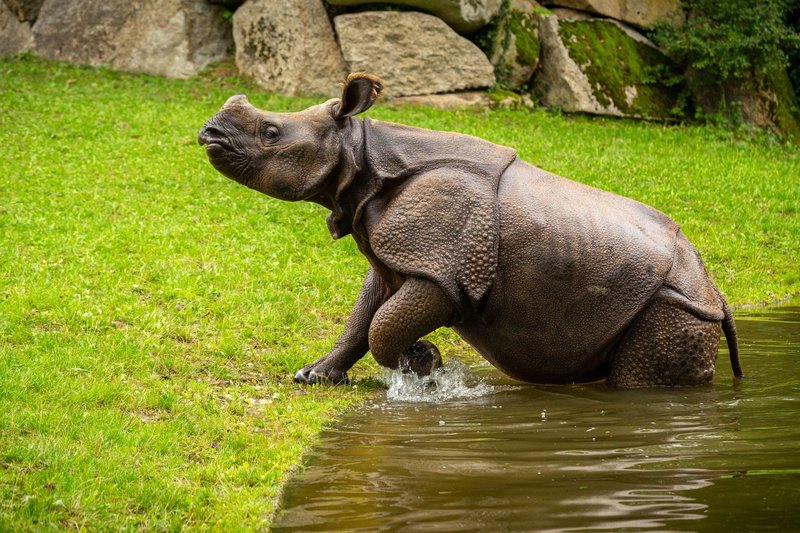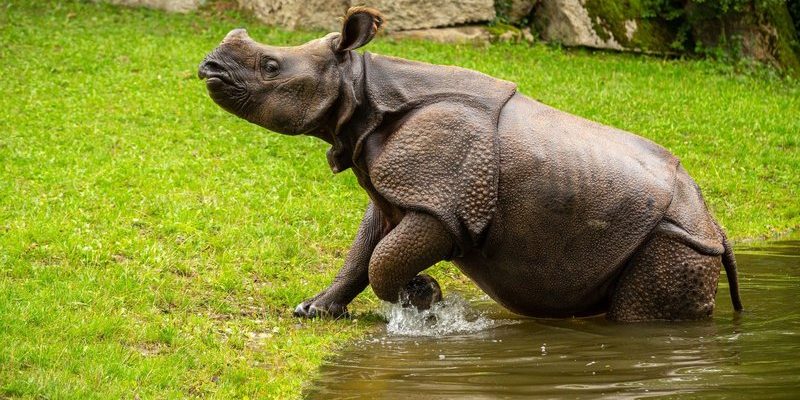
Rhinoceroses are among the oldest surviving species on our planet, with ancestors dating back millions of years. But today, they face great threats from habitat loss and poaching. Understanding these fascinating facts about rhinoceroses can help us appreciate them and maybe even inspire some action to protect them for future generations. So, let’s dive into some cool rhino facts that will leave you wanting to learn more!
1. There Are Five Species of Rhinoceros
Here’s the thing: Not all rhinos are the same! There are five distinct species of rhinoceros: White Rhino, Black Rhino, Indian Rhino, Javan Rhino, and Sumatran Rhino. Each type has its own unique characteristics and adaptations.
– White Rhinoceros: The largest of the species and often confused with the black rhino due to their similar sizes. White rhinos are more social and prefer to stay in groups.
– Black Rhinoceros: Smaller and more solitary, black rhinos are known for their pointed upper lip, which helps them grasp branches and leaves when they feed.
– Indian Rhinoceros: This species stands out with its one horn and thick, wrinkled skin that resembles armor.
– Javan Rhinoceros: The rarest of the five, with only about 76 individuals left, found mainly in Ujung Kulon National Park in Indonesia.
– Sumatran Rhinoceros: The smallest species, characterized by its hairy body and two horns, and is critically endangered.
By learning about these species, we can better understand the ecosystems they inhabit and why they matter.
2. Rhinoceroses Are Herbivores
Honestly, despite their tough exterior, rhinoceroses are gentle giants. They are herbivores, which means their diet primarily consists of plants. You might think of them as massive lawnmowers, grazing on grasses, leaves, and shrubs.
– Feeding Habits: Different species have different feeding preferences. For instance, the black rhino loves to munch on bushes and trees, while the white rhino mainly grazes on grasslands.
– Impact on Ecosystem: By consuming large amounts of vegetation, rhinos help shape their habitats. They create pathways through dense vegetation and allow other animals access to food and shelter.
So, next time you see a rhino, remember they play a vital role in maintaining the balance of their environment, much like bees do in pollination.
3. Rhinos Have Thick Skin That Protects Them
If you’ve ever touched a rhino’s skin, you’d notice it’s surprisingly thick—about 1.5 to 5 cm! This tough armor-like layer is essential for their survival. Think of it as their natural bodyguard.
– Defense Mechanism: While rhinos are not aggressive, they need protection from predators and harsh weather. Their thick skin helps shield them from injuries while they navigate through thorny bushes.
– Sun Protection: Rhinos are also sensitive to the sun. Their skin can easily get sunburned, so they often wallow in mud or water. This not only cools them down but creates a protective layer against the sun’s rays.
This mud bath is like their spa day, helping keep them clean and cool.
4. Rhinoceroses Have Amazing Hearing and Smell
You might be surprised to learn that rhinos don’t rely heavily on their eyesight. Instead, they have fantastic hearing and an incredible sense of smell. This is vital for survival, especially given their large size.
– Hearing: Rhinos can hear sounds that humans can’t, picking up the faintest rustle in the bush. This helps them stay alert to potential danger.
– Smell: Their sense of smell is so strong that they can detect predators and familiar individuals from several miles away. This capability is crucial when they roam their territories, ensuring they can find food and avoid threats.
So, while they might seem slow and lumbering, they’re quite aware of their surroundings!
5. Rhinos Have Unique Horns Made of Keratin
Let me explain the fascination behind a rhino’s horn. Contrary to popular belief, a rhino’s horn isn’t made of bone; it’s composed of keratin, the same material found in our hair and nails.
– Purpose of the Horn: Rhinos use their horns for various purposes, such as defense against predators and competition with other rhinos. Males often engage in fierce battles during mating season, and their horn becomes a crucial tool in determining dominance.
– Poaching Crisis: Unfortunately, the demand for rhino horns in traditional medicine and as a status symbol in some cultures has led to drastic declines in rhino populations. Because of this, conservation efforts are critical to protect these majestic creatures.
It’s heart-wrenching to think that these stunning animals are targeted for something so similar to what we have naturally.
6. Rhinos Are Social Creatures—Sort Of
You might picture rhinos as solitary animals, but that’s not entirely true. While most of the time they prefer to be alone, they also engage in social behaviors.
– White Rhinos: They’re more social than their cousins and can often be seen grazing together in groups known as “crashes.”
– Black Rhinos: These guys tend to be more solitary and are less likely to socialize, though females may stay with their young for a couple of years.
Their social structures highlight the complexities of their behaviors and interactions.
7. They Have Long Gestation Periods
Pregnancy for rhinoceroses is no quick trip. In fact, a rhino’s gestation period can last anywhere from 15 to 16 months, which is quite long, even in the animal kingdom!
– Calves: Once born, a rhino calf weighs around 50 pounds! They stay close to their mothers for safety and nourishment for several years, learning essential survival skills.
– Motherly Care: A mother rhino is fiercely protective of her young. She teaches them how to forage for food, recognize danger, and navigate their environment.
The bond between a mother and her calf is beautiful and incredibly strong, reflecting the care they give to ensure their young thrive.
8. Rhinos Can Live for a Long Time
Ever wondered how long a rhino can live? These magnificent creatures can live up to 40-50 years in the wild, provided they aren’t disrupted by poaching or habitat loss.
– Lifespan in Captivity: Rhinos in zoos and wildlife reserves tend to live even longer, often reaching up to 60 years due to better care, consistent food supply, and lack of predators.
– Conservation: With proper conservation efforts, we can help ensure that these magnificent beasts can enjoy their long lives in the wild.
Living a long life gives them plenty of time to contribute to their ecosystem and teach the next generation.
9. They Have Unique Communication Methods
Communication among rhinos is fascinating! They use a variety of sounds, facial expressions, and even body language to convey messages.
– Vocalizations: Rhinos can grunt, snort, and bellow to express different feelings, such as distress or excitement.
– Scent Marking: They also communicate through scent by marking their territory with urine and dung, letting others know who’s in charge of the area.
Understanding how rhinos communicate offers insight into their social dynamics and helps researchers protect them better.
10. Rhinoceroses Face Extinction Threats
Here’s the reality: rhinoceroses are facing severe threats, primarily due to habitat loss and poaching. With awareness and conservation, there’s hope for their future.
– Conservation Efforts: Organizations around the globe are working to protect rhinos through anti-poaching initiatives, habitat preservation, and breeding programs.
– What We Can Do: Supporting wildlife organizations, spreading awareness, and advocating for protective laws can help ensure that future generations get to marvel at these incredible animals.
By recognizing the challenges rhinos face, we can all play a part in their survival story.
In conclusion, rhinoceroses are more than just their massive size and iconic horns; they are complex creatures that play vital roles in their ecosystems. Understanding these fascinating facts helps shed light on the importance of protecting them. Let’s work together to ensure that these majestic animals continue to roam the earth for years to come.

